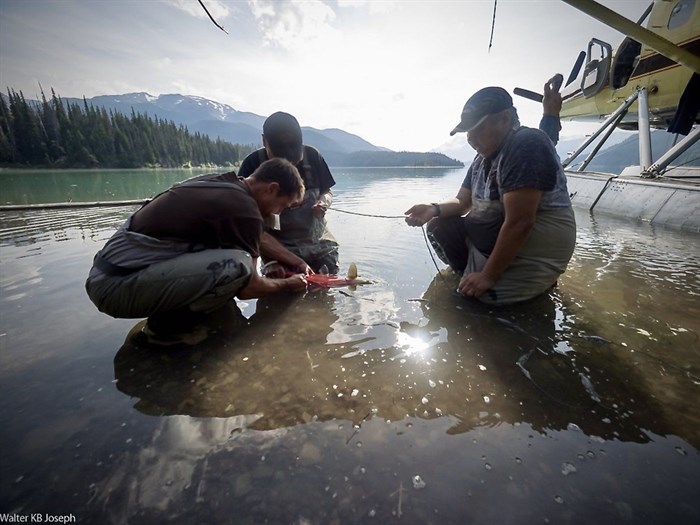
SFU researcher Michael Price and Wet'suwet'en Guardians examine a sockeye salmon.
Image Credit: Walter KB Joseph/Simon Fraser University
January 21, 2024 - 6:00 PM
Climate change has tipped the scales, causing juvenile sockeye salmon in B.C. to grow bigger over the past century.
The growth of salmon using lakes as nurseries during the first years of life in northern B.C. is about 35 per cent higher than 100 years ago, a new study from Simon Fraser University shows.
Warmer lake temperatures can spur salmon to grow faster by boosting their metabolism and their ability to capture prey, as well as increasing the food supply for fish, said SFU researcher Michael Price.
However, it’s not a given that bigger is always better, said Price, who led the study looking at how salmon populations are adapting to global warming in different freshwater habitats in the Skeena River watershed.
“The prevailing thought is, ‘Yes, bigger is better,’” he said. “But there is some complication here.”
Evidence generally suggests the larger a juvenile salmon is when it heads out to sea, the more likely it is to survive.
Juvenile sockeye can spend up to three years in lakes depending on the amount of food and competition they have before getting big enough to journey to the ocean.
However, juvenile salmon growth is now accelerating during their first year of life — prompting more fish to exit lakes early for saltwater rather than hanging back to bulk up for a second year.
This increasing growth and earlier migration may not be entirely a good thing, Price said.
“A fish might be bigger as a one-year-old but in the past, it would have stayed over another year and left as a two-year-old that’s twice the size,” he said, noting it might decrease fish survival in the ocean in some instances.
There are also limits to this overall growth, Price noted.
Although warmer water may be driving juvenile fish growth, as coldwater fish, salmon still have a thermal sweet spot for water between 10 C and 15 C, with more limited growth until about 19 C, and temperatures above 20 C becoming increasingly stressful or lethal.
Another interesting finding of the study was the quality of fish habitat is also shifting with the rise in temperatures — for better and worse, Price said.
Deeper, colder lakes that might not have been fruitful in the past now produce more food and allow for better growth as they warm up — while also allowing young salmon refuge from extreme summer surface temperatures in water lower down.
Conversely, warmer and shallower lakes where fish thrived in the past are likely to become less productive as temperatures climb.
Additionally, fish used to typically grow most in the summer when temperatures were warmer. However, the rise in temperature in the Skeena watershed has been more dramatic in the winter, Price said.
This means less ice and warmer lakes are allowing fish to grow during the winter while fish growth in habitats that are too warm in summer may slow or stall.
Salmon are starting to show up in rivers and lakes in the Skeena watershed that previously weren’t considered prime habitat, Price said.
It’s potentially a hopeful outcome that can guide fish conservation and political decisions about land use like development, mining or forestry moving forward, he said.
A variety of new and diverse freshwater habitats will help salmon and the watersheds they depend on be more resilient to climate change.
“They provide the opportunities for salmon to adapt and thrive,” he said.
“But in the end, it's going to be up to us whether we ensure that these habitats remain intact for salmon in the future.”
— This story was originally published by Canada’s National Observer.
News from © iNFOnews, 2024